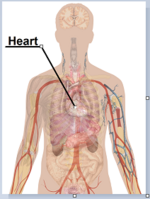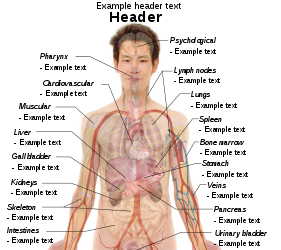Fitxer:Stem cell treatments.png

Fitxer original (2.417 × 1.983 píxels, mida del fitxer: 1,38 Mo, tipus MIME: image/png)
| Aquest fitxer i la informació mostrada a continuació provenen del dipòsit multimèdia lliure Wikimedia Commons. |
Contingut
Resum
References
Diabetes, rheumatoid arthritis, Parkinson's, Alzheimer's disease, osteoarthritis:
- Cell Basics: What are the potential uses of human stem cells and the obstacles that must be overcome before these potential uses will be realized? archive copy at the Wayback Machine. In Stem Cell Information World Wide Web site. Bethesda, MD: National Institutes of Health, U.S. Department of Health and Human Services, 2009. cited Sunday, April 26, 2009
Stroke and traumatic brain injury repair:
- Stem Cells Tapped to Replenish Organs thescientist.com, Nov 2000. By Douglas Steinberg
Learning defects:
- ISRAEL21c > Israeli scientists reverse brain birth defects using stem cells December 25, 2008. (Researchers from the Hebrew University of Jerusalem-Hadassah Medical led by Prof. Joseph Yanai)
Spinal cord injury repair:
- Kang KS, Kim SW, Oh YH, et al (2005). "A 37-year-old spinal cord-injured female patient, transplanted of multipotent stem cells from human UC blood, with improved sensory perception and mobility, both functionally and morphologically: a case study". Cytotherapy 7 (4): 368–73. DOI:10.1080/14653240500238160. PMID 16162459.
Heart infarction:
- Strauer BE, Schannwell CM, Brehm M (April 2009). "Therapeutic potentials of stem cells in cardiac diseases". Minerva Cardioangiol 57 (2): 249–67. PMID 19274033.
Anti-cancer:
- Stem Cells Tapped to Replenish Organs thescientist.com, Nov 2000. By Douglas Steinberg
Baldness:
- Hair Cloning Nears Reality as Baldness Cure WebMD November 2004
Replace missing teeth:
- Yen AH, Sharpe PT (January 2008). "Stem cells and tooth tissue engineering". Cell Tissue Res. 331 (1): 359–72. DOI:10.1007/s00441-007-0467-6. PMID 17938970.
Repair hearing:
Restore vision:
Amyotrophic lateral sclerosis:
- Drs. Gearhart and Kerr of Johns Hopkins University. April 4, 2001 edition of JAMA (Vol. 285, 1691-1693)
Crohn's disease:
- Querida Anderson (2008-06-15). "Osiris Trumpets Its Adult Stem Cell Product". Genetic Engineering & Biotechnology News: 13. Mary Ann Liebert, Inc.. Retrieved on 2008-07-06. "(subtitle) Procymal is being developed in many indications, GvHD being the most advanced"
Wound healing:
- Gurtner GC, Callaghan, MJ and Longaker MT. 2007. Progress and potential for regenerative medicine. Annu. Rev. Med 58:299-312
Llicència
| Public domainPublic domainfalsefalse |
| Jo, el titular del copyright d'aquesta obra, l'allibero al domini públic. Això s'aplica a tot el món. En alguns països això pot no ser legalment possible, en tal cas: Jo faig concessió a tothom del dret d'usar aquesta obra per a qualsevol propòsit, sense cap condició llevat d'aquelles requerides per la llei. |
Human body diagramsMain article at: Human body diagrams Template location:Template:Human body diagrams How to derive an imageDerive directly from raster image with organsThe raster (.png format) images below have most commonly used organs already included, and text and lines can be added in almost any graphics editor. This is the easiest method, but does not leave any room for customizing what organs are shown. Adding text and lines: Derive "from scratch"By this method, body diagrams can be derived by pasting organs into one of the "plain" body images shown below. This method requires a graphics editor that can handle transparent images, in order to avoid white squares around the organs when pasting onto the body image. Pictures of organs are found on the project's main page. These were originally adapted to fit the male shadow/silhouette.
Organs:
Derive by vector templateThe Vector templates below can be used to derive images with, for example, Inkscape. This is the method with the greatest potential. See Human body diagrams/Inkscape tutorial for a basic description in how to do this.
Examples of derived works
Licensing
|
Llegendes
Elements representats en aquest fitxer
representa l'entitat
27 abr 2009
Historial del fitxer
Cliqueu una data/hora per veure el fitxer tal com era aleshores.
| Data/hora | Miniatura | Dimensions | Usuari/a | Comentari | |
|---|---|---|---|---|---|
| actual | 12:25, 19 feb 2012 |  | 2.417 × 1.983 (1,38 Mo) | Mikael Häggström | Updated |
| 06:48, 27 abr 2009 |  | 729 × 598 (346 Ko) | Mikael Häggström | {{Information |Description={{en|1=g}} |Source=Own work by uploader |Author=Mikael Häggström |Date=g |Permission= |other_versions= }} <!--{{ImageUpload|full}}--> |
Ús del fitxer
La pàgina següent utilitza aquest fitxer:
Ús global del fitxer
Utilització d'aquest fitxer en altres wikis:
- Utilització a az.wikipedia.org
- Utilització a en.wikipedia.org
- Utilització a es.wikipedia.org
- Utilització a hu.wikipedia.org
- Utilització a vi.wikipedia.org
Metadades
Aquest fitxer conté informació addicional, probablement afegida per la càmera digital o l'escàner utilitzat per a crear-lo o digitalitzar-lo. Si s'ha modificat posteriorment, alguns detalls poden no reflectir les dades reals del fitxer modificat.
| Resolució horitzontal | 59,06 ppc |
|---|---|
| Resolució vertical | 59,06 ppc |
| Programari utilitzat |
|

































